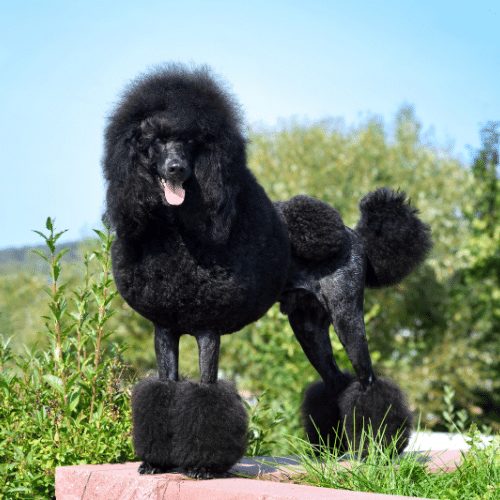Standard Poodle Growth Chart & Weight Calculator
February 6, 2021 2021-06-03 11:17Do you have a Standard Poodle pup and wonder how tall he or she will grow? Our growth calculator and charts will predict your dog’s adult weight. Simply put in your pup’s weight and age into our calculator and we will estimate the adult size!
Standard Poodle Weight Calculator & Growth Chart
Table of Contents

How big will my Standard Poodle get?
The AKC calls for Standard Poodles to be taller than 15 inches and weight 40-50 pounds (females) or 60-70 pounds (males). Most adult dogs reach a height at the withers of 18-24 inches.
Size genetics can vary quite a bit and even within puppies of one litter there could be big differences in adult size. When trying to predict your dog’s adult size based on his relatives, look at the grandparents, uncles and aunts as well as the parents.
Of course, you should never choose a dog based on looks alone – whether those are colors (like the Parti Poodle) or certain size requirements. However, if you want a specifically small dog, a female is more likely to fit the bill. On the other hand, if you want a large dog, pick a male.
Is a Standard Poodle a large breed dog?
Yes, Standard Poodles are large dogs. If you are unsure if you have the space and time to care for a Standard Poodle, don’t commit to one quite yet. Standard Poodles will require daily exercise and stimulation like every dog breed. They are very handler-focused and love to be with their people.
How big is a small Standard Poodle?
As per the AKC definition, any Poodle over 15 inches at the withers qualifies as a Standard Poodle. In reality finding a Standard Poodle who is just above this height would be highly unusual. Small females are closer to 18-19 inches tall.
If you are looking for a specifically small Poodle, going with a Toy or Miniature Poodle might be your best bet.
Do big Standard Poodles require more care?
Every dog is going to require daily care, exercise and enrichment, regardless of their size. However, there are a few factors that will consume more resources with a larger dog, such as:
- Food (of course, a large dog needs more calories than a small one)
- Grooming (brushing, shampooing, blowdrying, clipping will all take longer with a taller dog)
- Vet care (surgeries such as spay/neuter, medication, preventatives like heartworm medicine etc. usually cost more for large dogs)
- Crates (for your home, in the car etc. can cost considerably more for large dogs)
However, the amount of time you should spend with your dog every day is not any more or less for large dogs – every dog needs to spend bonding time with his owner every day.

